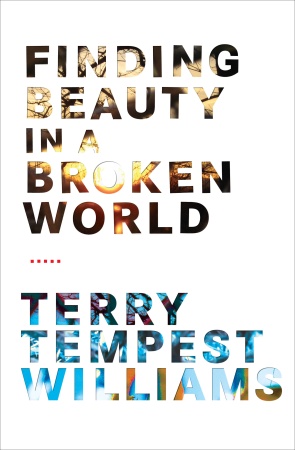
Finding Beauty in a Broken World
by Terry Tempest Williams
Form follows function in Terry Tempest Williams’ Finding Beauty in a Broken World. As she discovers beauty in what is broken, her text proceeds in pieces: clippings from newspapers and government reports, bits of legislation, quotes from old poets and pieces of her own poetry, dialogue and letters, time-stamped journal entries and field reports. Certain images repeat and reflect, like the bones of animals and humans, collected and preserved for study and memory, and hands clasped in prayer – statues in Italy, prairie dog gestures to the sun, Williams’ own hands “locked in that perpetual gesture of pleading and desire – a disembodied hand clutching a pencil….” This is a book – or several – torn apart and pieced together again.
Williams tells of her journey after 9/11 to Ravenna, Italy to learn the art of making mosaics (“a mosaic is a conversation between what is broken”). She proceeds to the American Southwest to study prairie dogs, and continues on to Rwanda to help build a genocide memorial.
Williams explains her pull to the prairie dogs, a species less attractive than, say, polar bears, more likely to be shot for sport than to be cooed at: “If one could chart one’s natural autobiography with an animal, my companion species would be the prairie dog. We are both tied to community. We both seek time above- and belowground. And we are both struggling with how to survive in a world we hardly recognize.”
Williams’ community is her family, the Tempest men who run a pipe construction company, whose physicality and relationship to the land she extols, in contrast to her writer’s life: “…I wondered what the men in my family know that I will never understand because of one simple thing – their tool of choice is a shovel.” They work in a cruel and beautiful land: “This is big, broken country born of faults, tilts, and thrusts, and a history of weathering. For all its stillness and the vast expanse of silence, this is tortured terrain.”
Time is sought in Williams’ book but never structured into story. Rather, it collapses like a Mad fold-in, past mingling with present, underground and above at the same time. In Italy, she makes mosaics in the method used for ages, looking up at the work of her predecessors. Of prairie dogs she notes that the animals have “survived the epic changes through time,” since the Pleistocene era, building elaborate burrows below ground and popping up in mounds “like a fist pushing from below.” She catalogs two weeks of studying the animals in journal entries with timed headings, sometimes only a few minutes apart: “Time is intimacy. It’s that simple.” Though she marks the hours, she does not wait for time to pass, she is not, as her family imagines, eager to return to the “real world.”
During her trip to Rwanda, which takes up the bulk of the book, genocide disrupts time – the brutal past is always present, in memories and memorials, in the ongoing violence, in churches heaped with bones and covered with bloodstains. This is where she seems to find the world most strange and beautiful: where an incomprehensible crime occurred, but where joy is still possible. As she writes, after an unexpected but apt ode to the Watts Towers, constructed from discarded scraps, “Finding beauty in a broken world is creating beauty in the world we find.”
Excerpt: “This is the story that lives inside me and drives my own hand across the page. It is not my wrist that bleeds, but my words. Blood. Bloodwork. Perhaps this is the act of writing, of conservation, of trying to make peace with our own contradictory nature. We love the land. We are destroying the land. We are eroding and evolving, at once.”
Further reading: Refuge: An Unnatural History of Family and Place




Send A Letter To the Editors